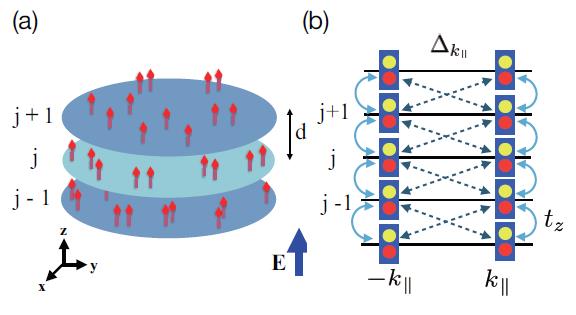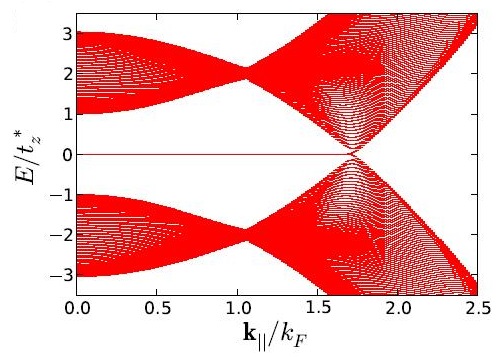

Topological Material Project: Quantum Degenerate Majorana Fermions
Introduction:
We investigate the topological properties of spin polarized fermionic polar molecules loaded in a multi-layer structure with the electric dipole moment polarized to the normal direction. When polar molecules are paired by attractive inter-layer interaction, unpaired Majorana fermions can be macroscopically generated in the top and bottom layers in dilute density regime. We show that the resulting topological state is effectively composed by a bundle of 1D Kitaev ladders labeled by in-plane momenta k and -k, and hence belongs to BDI class characterized by the winding number Z, protected by the time reversal symmetry. The Majorana surface modes exhibit a flatband at zero energy, fully gapped from Bogoliubov excitations in the bulk, and hence becomes an idea system to investigate the interaction effects on quantum degenerate Majorana fermions. We further show that additional interference fringes can be identified as a signature of such 2D Majorana surface modes in the time-of-flight experiment.

(Caption) (a) Multi-layer structure for identical fermionic polar molecules loaded into a deep 1D optical lattice. The electric dipole moment (arrows) is aligned to the normal (z) direction by the external field. (b) Effective Kitaev ladder in momentum space (see Eq. (2)), where fermions (rectangular boxes) in each "site" can be decomposed into two MFs (circles, see the text). Two unpaired MF can be found at the end of ladders. Double-sided arrows of dashed/sold lines indicate inter-layer pairing/hopping respectively (for simplicity, here we just show the configuration of a special case, where only pairs between neighboring layers are considered).
In the system described by Fig. 1(a), the full Hamiltonian including interlayer tunneling, in-plane kinetics, and the dipolar interaction between polar molecules are following:
.jpg)
It is easy to see that one could apply BCS theory by assuming only pairing between fermions in the different layers are possible. The resulting Hamiltonian then becomes
%202.jpg)
It is easy to see that such effective Hamitlian after using BCS approximation is nothing but a Kitaev ladder, where the pairing is between two 1D chains labeled by k and –k.
We therefore could show that the condition for topological superfluid can be also obtained easily as following:
%203.jpg)
This result is completely consistent with our numerical results by including long-ranged pairing. We further diagonalize the BCS Hamitlonian to check if the zero energy modes exists for the Majorana fermions at the surface layer. We find that it is indeed the case and as shown below:

(Caption) Single particle band structure of ladder Hamiltonian obtained by exactly diagonalizing L=100 layers with a long-ranged (dipolar) pairing.
The importance of this work is to show the possibility for realizing a many-body state with a macroscopically occupied Majorana surface mode in a multilayer structure. This will open a new direction for investigating the strongly correlated physics in terms of non-Abelian particles.
Publicatrion:
Research Team:
Ten-Ting Lin (Department of Physics, National Tsing Hua University)
Hao Lee (Department of Physics, National Tsing Hua University)
Prof. Ching-Yu Huang (Department of Physics, Tung-Hai University)
Prof. Daw-Wei Wang (Department of Physics, National Tsing Hua University; Physics Division, National Center for Theoretical Sciences)
©copyright Artificial Intelligence for Fundamental Research (AIFR) Group